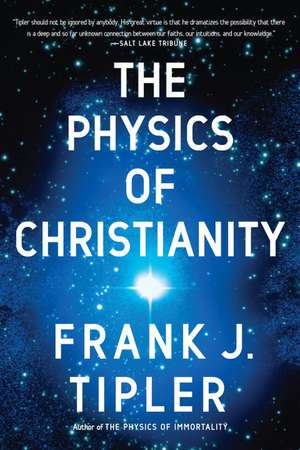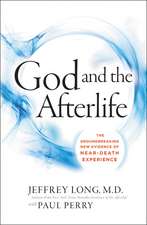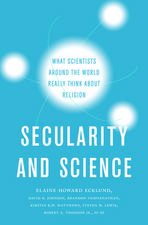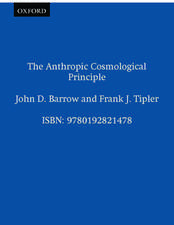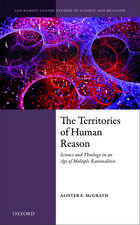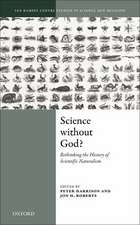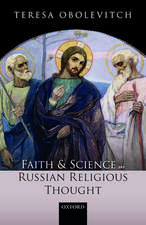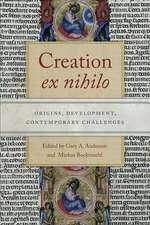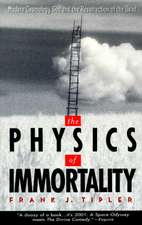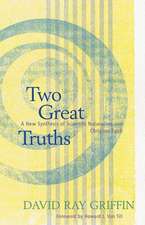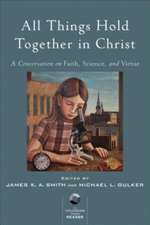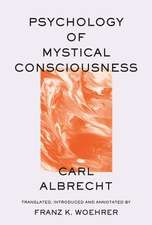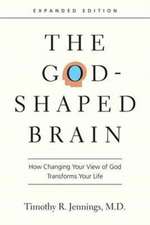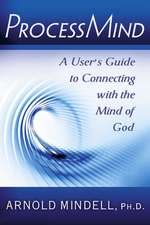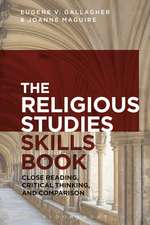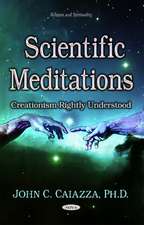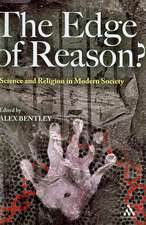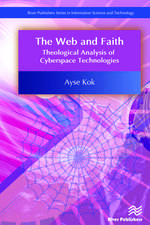The Physics of Christianity
Autor Frank J. Tipleren Limba Engleză Paperback – 31 iul 2008
Frank Tipler takes an exciting new approach to the age-old dispute about the relationship between science and religion in The Physics of Christianity. In reviewing centuries of writings and discussions, Tipler realized that in all the debate about science versus religion, there was no serious scientific research into central Christian claims and beliefs. So Tipler embarked on just such a scientific inquiry. The Physics of Christianity presents the fascinating results of his pioneering study.
Tipler begins by outlining the basic concepts of physics for the lay reader and brings to light the underlying connections between physics and theology. In a compelling example, he illustrates how the God depicted by Jews and Christians, the Uncaused First Cause, is completely consistent with the Cosmological Singularity, an entity whose existence is required by physical law. His discussion of the scientific possibility of miracles provides an impressive, credible scientific foundation for many of Christianity’s most astonishing claims, including the Virgin Birth, the Resurrection, and the Incarnation. He even includes specific outlines for practical experiments that can help prove the validity of the “miracles” at the heart of Christianity.
Tipler’s thoroughly rational approach and fully accessible style sets The Physics of Christianity apart from other books dealing with conflicts between science and religion. It will appeal not only to Christian readers, but also to anyone interested in an issue that triggers heated and divisive intellectual and cultural debates.
Preț: 107.27 lei
Nou
Puncte Express: 161
Preț estimativ în valută:
20.53€ • 22.31$ • 17.26£
20.53€ • 22.31$ • 17.26£
Carte disponibilă
Livrare economică 31 martie-14 aprilie
Preluare comenzi: 021 569.72.76
Specificații
ISBN-13: 9780385514255
ISBN-10: 0385514255
Pagini: 319
Dimensiuni: 133 x 203 x 19 mm
Greutate: 0.25 kg
Editura: Doubleday Books
ISBN-10: 0385514255
Pagini: 319
Dimensiuni: 133 x 203 x 19 mm
Greutate: 0.25 kg
Editura: Doubleday Books
Notă biografică
FRANK J. TIPLER is a professor of mathematical physics at Tulane University and the author of The Physics of Immortality. He lives in New Orleans, Louisiana.
Extras
I
Introduction: Christianity as Physics
The latest observations of the cosmic background radiation show that the universe began 13.7 billion years ago at the Singularity. Stephen Hawking proved mathematically that the Singularity is not in time or in space, but outside both. In other words, the Singularity is transcendent to space and time. According to the theologian Thomas Aquinas, “God created the Universe” means simply that all causal chains begin in God. God is the Uncaused Cause. In physics, all causal chains begin in the Singularity. The Singularity itself has no cause. For a thousand years and more, Christian theologians have asserted that there is one and only one “achieved” (actually existing) infinity, and that infinity is God. The Cosmological Singularity is an achieved infinity.
The Cosmological Singularity is God.
“But,” the average person may protest, “the ‘Cosmological Singularity’ is not my idea of God. I picture God as a kindly, white–haired old man, loving but with immense power. The ‘Cosmological Singularity’ (whatever that is) is too abstract, too intellectual to be my God, the God I pray to every night. It sounds like some crazy idea some physicist would dream up. It’s definitely not the God of Judaism or Christianity.”
Not so. The Cosmological Singularity is the Judeo–Christian God. Think of it this way. Everybody knows that when you flip a light switch, the light goes on because an electrical current flows in the wires in the walls. Everybody also knows that electrons carry the electric charge whose motion makes the electric current. I invite you to imagine an “electron”—you must have some image of an electron, since you use the word.
Now let me ask you: when you imagined an “electron,” did you imagine an excitation of a quantized, relativistic fermion field, part of an electroweak doublet? Unless you are a professional physicist, I know you didn’t. You probably imagined a little ball of some sort. Such an image is good for some purposes, even in physics. One can compute a fairly accurate value for the “drift velocity” of the electrons through the wire using the “little ball” image of the electron. But did you know that the electrons which carry the current in the wire are at a temperature of 80,000 degrees Celsius (140,000 degrees Fahrenheit)? (1) You might wonder, If the conduction electrons are at that high a temperature, why don't they melt the wires? Why don't they start a fire and burn the house down? The reason is that the conduction electrons can't give up their high–temperature energy to the wires. But to understand why the electrons can’t give up their energy, one has to go beyond the “little ball” image of the electron. (One has to think “quantized fermion.”)
Similarly, everyone has an image of “God,” but to really understand what God really is and how He could interact with the universe, one must use a theory beyond everyday commonsense physics. Contrary to what many physicists have claimed in the popular press, we have had a Theory of Everything for about thirty years. Most physicists dislike this Theory of Everything because it requires the universe to begin in a singularity. That is, they dislike it because the theory is consistent only if God exists, and most contemporary scientists are atheists. They don’t want God to exist, and if keeping God out of science requires rejecting physical laws, well, so be it.
My approach to reality is different. I believe that we have to accept the implications of physical law, whatever these implications are. If they imply the existence of God, well then, God exists.
We can also use the physical laws to tell us what the Cosmological Singularity—God—is like. The laws of physics tell us that our universe began in an initial singularity, and it will end in a final singularity. The laws also tell us that ours is but one of an infinite number of universes, all of which begin and end in a singularity. If we look carefully at the collection of all the universes—this collection is called the multiverse—we see that there is a third singularity, at which the multiverse began. But physics shows us that these three apparently distinct singularities are actually one singularity. The Three are One.
There is one religion which claims that God is a Trinity: Christianity. According to Christianity, God consists of Three Persons: God the Father (the First Person), God the Son (the Second Person), and God the Holy Ghost (the Third Person). But there are not three Gods, only one God. Using physics to study the structure of the Cosmological Singularity, we can see that indeed the three “parts” of the Singularity can be distinguished by employing the idea of personhood. In particular, physics can be used to show how it is possible for a man—Jesus, according to Christianity—to actually be the part of the Singularity that connects the Initial and Final Singularities. So the Incarnation makes perfectly good sense from the point of view of physics.
Traditional Christianity has always claimed that “miracles” do not violate ultimate physical law, although a miracle may violate our limited knowledge of physical law. Thus, if we know ultimate physical law—and if our Theory of Everything is correct, we do—we should be able to explain all the miracles of Christianity.
And so we can. The miracle of the Star of Bethlehem was a supernova in the Andromeda Galaxy. The miracle of the Virgin Birth of Jesus, the virgin birth of a male, is plausible if we use modern knowledge of exactly how DNA codes for gender. One expects that, in a virgin birth, all the DNA in the child would come from the mother alone. This is possible if Jesus were an XX male. In the U.S. population, 1 male in 20,000 is an XX male. Using modern DNA technology, it is a simple matter to test whether a male is an XX male. A DNA test was performed on the Shroud of Turin, claimed to be the burial shroud of Jesus, and the Oviedo Cloth, claimed to be the “napkin” that covered Jesus’ face in his tomb. The DNA on both relics is just what one would expect if it were the DNA of an XX male.
According to Christians, Jesus rose from the dead in a “resurrection body,” a body that we will all have at the Universal Resurrection in the future. This “Glorified Body” was capable of “dematerializing” at one location and “materializing” in another. Modern particle physics provides a mechanism for dematerialization: conversion of the matter of an object into neutrinos, which are elementary particles that interact very weakly with normal matter and thus would be invisible. Reversing the process would result in apparently materializing out of nothing. If this was the mechanism of Jesus’ Resurrection, there are several tests that could demonstrate it. In fact, some of these tests are so simple that an ordinary person could carry them out. The image of Jesus on the Turin Shroud has certain features we would expect to arise in the neutrino dematerialization process.
Christians claim that Jesus will come again, at the end of human history. Two developments in physics suggest that human history will end in about fifty years: computer experts predict that computers will exceed human intelligence within fifty years, and the dematerialization mechanism can be used to make weapons that are to atomic bombs as atomic bombs are to spitballs. Such weapons and superhuman computers would make human survival unlikely, and in his discussion of the Second Coming, Jesus said he would return when humans faced a “Great Tribulation” of such magnitude that we would not survive without his direct intervention. We will face such a Great Tribulation within fifty years.
From the perspective of the latest physical theories, Christianity is not a mere religion but an experimentally testable science.
II
A Brief Outline of Modern Physics
The Many–Worlds Interpretation is trivially true. — Stephen W. Hawking (1)
The [Many–Histories Interpretation] is okay. — Murray Gell–Mann, Physics Nobel laureate (2)
The final approach [to quantum mechanics] is to take the Schrodinger equation seriously, to give up the dualism of the Copenhagen interpretation, and to try to explain its successful rules through a description of measurer and their apparatus in terms of the same deterministic evolution of the wave function that governs everything else…For what it is worth, I prefer this last approach. — Steven Weinberg, Physics Nobel laureate (3)
I question whether quantum mechanics is the complete and ultimate truth about the physical universe. In particular, I question whether the superposition principle can be extrapolated to the macroscopic level in the way required to generate the quantum measurement paradox…I simply cannot convince myself that any of the solutions proffered to the quantum measurement paradox is philosophically [my emphasis] satisfactory. — Anthony Leggett, Physics Nobel laureate (4)
I’m afraid I do [believe in the Many-Worlds Interpretation]. I agree with John Wheeler who once said that is too much philosophical [my emphasis] baggage to carry around, but I can’t see how to avoid carrying that baggage. — Philip Anderson, Physics Nobel laureate (5)
I think we are forced to accept the Many–Worlds Interpretation if quantum mechanics is true. — Richard P. Feynman, Physics Nobel laureate (6)
I don’t see any way to avoid the Many–Worlds Interpretation, but I wish someone would discover a way out. — Leon Lederman, Physics Nobel laureate (7)
Jesus answered, “My kingdom is not of this world.” — John 18:36
Modern physics is based on three fundamental theories: quantum mechanics, general relativity, and the Standard Model of particle physics. In the popular press—and even in many technical physics journals—one will find much discussion of other theories, for example, inflation cosmology, superstring theory, and M–theory. Ignore these other theories. They have no experimental support whatsoever. In contrast, quantum mechanics, general relativity, and the Standard Model have enormous support from experiment. All three theories have made predictions again and again over many decades, predictions that are completely counterintuitive to scientists and the average person, and all of these counter–to–common–sense predictions have been confirmed by experiment. A scientist, if he wishes to remain a scientist, must accept the results of experiment, and nothing but the results of experiment.
Unfortunately, many scientists, even many very good scientists, have a tendency to reject the firmly established physical laws once they realize that these laws have implications which are contrary to the intuitive picture of the world which these scientists formed in childhood. When any scientist rejects the implications of physical law, for any reason other than experiment, then he ceases to be a scientist. He becomes a philosopher, practicing a discipline in which he has no special expertise. When he rejects the implications of physical law without experimental warrant, he is no longer speaking as a scientist; he is speaking as a layman, with no more authority that the average person in the street.
Fortunately, when a scientist leaves the discipline in which his expertise rests for philosophy, he generally retains his scientific habits of honesty. If pressed, he will tell you that he is no longer speaking as a scientist but as a philosopher. Just ask him what the experimental evidence is for his claim, any claim. He will generally tell you that there is none. Any scientist can cite at length the experimental evidence for a true scientific claim.
This will also apply to me. I could talk for hours on the experiments that indicate the truth of quantum mechanics, general relativity, and the Standard Model. Any physicist could, even in those all too common cases when a particular physicist has decided on philosophical grounds that there must be something wrong with one or more of these fundamental theories. Just ask any physicist for the experimental evidence for any of these theories, or consult the physics textbooks. I am therefore not going to waste any space defending the truth of these three fundamental theories of modern physics; I am just going to outline what these theories assert about the nature of physical reality. I’m going to assume that all three theories are actually true. Once again, there is no experiment at all that even suggests otherwise.
Quantum Mechanics
Of the three, quantum mechanics is the most fundamental theory, and also the most counter to everyday intuition about how the physical world operates. Quantum mechanics asserts that every object in the universe—an electron, a chair, you and me, the planet Earth, and the entire universe itself—is simultaneously both a particle and a wave. Unfortunately, our daily experiences cause us to think that the categories of “particle” and “wave” are mutually exclusive, and what makes the theory of quantum mechanics so counterintuitive is its claim that actually everything is both. Even physicists, who know there is overwhelming evidence that everything is simultaneously both a particle and a wave, find it hard to understand. Let me try to explain how this is possible.
A particle is easy to imagine: a ball flying through the air is an excellent model for all particles. A good image for a wave is a wave in the sea, coming in toward the shore. One obvious difference between particles and waves is the fact that the former are localized in space, whereas the latter are spread out in space. But there is a more basic difference: two or more waves can interfere with one another, and interfere either constructively or destructively. As we will see, it is this phenomenon of interference that is crucial to understanding quantum mechanics.
From the Hardcover edition.
Introduction: Christianity as Physics
The latest observations of the cosmic background radiation show that the universe began 13.7 billion years ago at the Singularity. Stephen Hawking proved mathematically that the Singularity is not in time or in space, but outside both. In other words, the Singularity is transcendent to space and time. According to the theologian Thomas Aquinas, “God created the Universe” means simply that all causal chains begin in God. God is the Uncaused Cause. In physics, all causal chains begin in the Singularity. The Singularity itself has no cause. For a thousand years and more, Christian theologians have asserted that there is one and only one “achieved” (actually existing) infinity, and that infinity is God. The Cosmological Singularity is an achieved infinity.
The Cosmological Singularity is God.
“But,” the average person may protest, “the ‘Cosmological Singularity’ is not my idea of God. I picture God as a kindly, white–haired old man, loving but with immense power. The ‘Cosmological Singularity’ (whatever that is) is too abstract, too intellectual to be my God, the God I pray to every night. It sounds like some crazy idea some physicist would dream up. It’s definitely not the God of Judaism or Christianity.”
Not so. The Cosmological Singularity is the Judeo–Christian God. Think of it this way. Everybody knows that when you flip a light switch, the light goes on because an electrical current flows in the wires in the walls. Everybody also knows that electrons carry the electric charge whose motion makes the electric current. I invite you to imagine an “electron”—you must have some image of an electron, since you use the word.
Now let me ask you: when you imagined an “electron,” did you imagine an excitation of a quantized, relativistic fermion field, part of an electroweak doublet? Unless you are a professional physicist, I know you didn’t. You probably imagined a little ball of some sort. Such an image is good for some purposes, even in physics. One can compute a fairly accurate value for the “drift velocity” of the electrons through the wire using the “little ball” image of the electron. But did you know that the electrons which carry the current in the wire are at a temperature of 80,000 degrees Celsius (140,000 degrees Fahrenheit)? (1) You might wonder, If the conduction electrons are at that high a temperature, why don't they melt the wires? Why don't they start a fire and burn the house down? The reason is that the conduction electrons can't give up their high–temperature energy to the wires. But to understand why the electrons can’t give up their energy, one has to go beyond the “little ball” image of the electron. (One has to think “quantized fermion.”)
Similarly, everyone has an image of “God,” but to really understand what God really is and how He could interact with the universe, one must use a theory beyond everyday commonsense physics. Contrary to what many physicists have claimed in the popular press, we have had a Theory of Everything for about thirty years. Most physicists dislike this Theory of Everything because it requires the universe to begin in a singularity. That is, they dislike it because the theory is consistent only if God exists, and most contemporary scientists are atheists. They don’t want God to exist, and if keeping God out of science requires rejecting physical laws, well, so be it.
My approach to reality is different. I believe that we have to accept the implications of physical law, whatever these implications are. If they imply the existence of God, well then, God exists.
We can also use the physical laws to tell us what the Cosmological Singularity—God—is like. The laws of physics tell us that our universe began in an initial singularity, and it will end in a final singularity. The laws also tell us that ours is but one of an infinite number of universes, all of which begin and end in a singularity. If we look carefully at the collection of all the universes—this collection is called the multiverse—we see that there is a third singularity, at which the multiverse began. But physics shows us that these three apparently distinct singularities are actually one singularity. The Three are One.
There is one religion which claims that God is a Trinity: Christianity. According to Christianity, God consists of Three Persons: God the Father (the First Person), God the Son (the Second Person), and God the Holy Ghost (the Third Person). But there are not three Gods, only one God. Using physics to study the structure of the Cosmological Singularity, we can see that indeed the three “parts” of the Singularity can be distinguished by employing the idea of personhood. In particular, physics can be used to show how it is possible for a man—Jesus, according to Christianity—to actually be the part of the Singularity that connects the Initial and Final Singularities. So the Incarnation makes perfectly good sense from the point of view of physics.
Traditional Christianity has always claimed that “miracles” do not violate ultimate physical law, although a miracle may violate our limited knowledge of physical law. Thus, if we know ultimate physical law—and if our Theory of Everything is correct, we do—we should be able to explain all the miracles of Christianity.
And so we can. The miracle of the Star of Bethlehem was a supernova in the Andromeda Galaxy. The miracle of the Virgin Birth of Jesus, the virgin birth of a male, is plausible if we use modern knowledge of exactly how DNA codes for gender. One expects that, in a virgin birth, all the DNA in the child would come from the mother alone. This is possible if Jesus were an XX male. In the U.S. population, 1 male in 20,000 is an XX male. Using modern DNA technology, it is a simple matter to test whether a male is an XX male. A DNA test was performed on the Shroud of Turin, claimed to be the burial shroud of Jesus, and the Oviedo Cloth, claimed to be the “napkin” that covered Jesus’ face in his tomb. The DNA on both relics is just what one would expect if it were the DNA of an XX male.
According to Christians, Jesus rose from the dead in a “resurrection body,” a body that we will all have at the Universal Resurrection in the future. This “Glorified Body” was capable of “dematerializing” at one location and “materializing” in another. Modern particle physics provides a mechanism for dematerialization: conversion of the matter of an object into neutrinos, which are elementary particles that interact very weakly with normal matter and thus would be invisible. Reversing the process would result in apparently materializing out of nothing. If this was the mechanism of Jesus’ Resurrection, there are several tests that could demonstrate it. In fact, some of these tests are so simple that an ordinary person could carry them out. The image of Jesus on the Turin Shroud has certain features we would expect to arise in the neutrino dematerialization process.
Christians claim that Jesus will come again, at the end of human history. Two developments in physics suggest that human history will end in about fifty years: computer experts predict that computers will exceed human intelligence within fifty years, and the dematerialization mechanism can be used to make weapons that are to atomic bombs as atomic bombs are to spitballs. Such weapons and superhuman computers would make human survival unlikely, and in his discussion of the Second Coming, Jesus said he would return when humans faced a “Great Tribulation” of such magnitude that we would not survive without his direct intervention. We will face such a Great Tribulation within fifty years.
From the perspective of the latest physical theories, Christianity is not a mere religion but an experimentally testable science.
II
A Brief Outline of Modern Physics
The Many–Worlds Interpretation is trivially true. — Stephen W. Hawking (1)
The [Many–Histories Interpretation] is okay. — Murray Gell–Mann, Physics Nobel laureate (2)
The final approach [to quantum mechanics] is to take the Schrodinger equation seriously, to give up the dualism of the Copenhagen interpretation, and to try to explain its successful rules through a description of measurer and their apparatus in terms of the same deterministic evolution of the wave function that governs everything else…For what it is worth, I prefer this last approach. — Steven Weinberg, Physics Nobel laureate (3)
I question whether quantum mechanics is the complete and ultimate truth about the physical universe. In particular, I question whether the superposition principle can be extrapolated to the macroscopic level in the way required to generate the quantum measurement paradox…I simply cannot convince myself that any of the solutions proffered to the quantum measurement paradox is philosophically [my emphasis] satisfactory. — Anthony Leggett, Physics Nobel laureate (4)
I’m afraid I do [believe in the Many-Worlds Interpretation]. I agree with John Wheeler who once said that is too much philosophical [my emphasis] baggage to carry around, but I can’t see how to avoid carrying that baggage. — Philip Anderson, Physics Nobel laureate (5)
I think we are forced to accept the Many–Worlds Interpretation if quantum mechanics is true. — Richard P. Feynman, Physics Nobel laureate (6)
I don’t see any way to avoid the Many–Worlds Interpretation, but I wish someone would discover a way out. — Leon Lederman, Physics Nobel laureate (7)
Jesus answered, “My kingdom is not of this world.” — John 18:36
Modern physics is based on three fundamental theories: quantum mechanics, general relativity, and the Standard Model of particle physics. In the popular press—and even in many technical physics journals—one will find much discussion of other theories, for example, inflation cosmology, superstring theory, and M–theory. Ignore these other theories. They have no experimental support whatsoever. In contrast, quantum mechanics, general relativity, and the Standard Model have enormous support from experiment. All three theories have made predictions again and again over many decades, predictions that are completely counterintuitive to scientists and the average person, and all of these counter–to–common–sense predictions have been confirmed by experiment. A scientist, if he wishes to remain a scientist, must accept the results of experiment, and nothing but the results of experiment.
Unfortunately, many scientists, even many very good scientists, have a tendency to reject the firmly established physical laws once they realize that these laws have implications which are contrary to the intuitive picture of the world which these scientists formed in childhood. When any scientist rejects the implications of physical law, for any reason other than experiment, then he ceases to be a scientist. He becomes a philosopher, practicing a discipline in which he has no special expertise. When he rejects the implications of physical law without experimental warrant, he is no longer speaking as a scientist; he is speaking as a layman, with no more authority that the average person in the street.
Fortunately, when a scientist leaves the discipline in which his expertise rests for philosophy, he generally retains his scientific habits of honesty. If pressed, he will tell you that he is no longer speaking as a scientist but as a philosopher. Just ask him what the experimental evidence is for his claim, any claim. He will generally tell you that there is none. Any scientist can cite at length the experimental evidence for a true scientific claim.
This will also apply to me. I could talk for hours on the experiments that indicate the truth of quantum mechanics, general relativity, and the Standard Model. Any physicist could, even in those all too common cases when a particular physicist has decided on philosophical grounds that there must be something wrong with one or more of these fundamental theories. Just ask any physicist for the experimental evidence for any of these theories, or consult the physics textbooks. I am therefore not going to waste any space defending the truth of these three fundamental theories of modern physics; I am just going to outline what these theories assert about the nature of physical reality. I’m going to assume that all three theories are actually true. Once again, there is no experiment at all that even suggests otherwise.
Quantum Mechanics
Of the three, quantum mechanics is the most fundamental theory, and also the most counter to everyday intuition about how the physical world operates. Quantum mechanics asserts that every object in the universe—an electron, a chair, you and me, the planet Earth, and the entire universe itself—is simultaneously both a particle and a wave. Unfortunately, our daily experiences cause us to think that the categories of “particle” and “wave” are mutually exclusive, and what makes the theory of quantum mechanics so counterintuitive is its claim that actually everything is both. Even physicists, who know there is overwhelming evidence that everything is simultaneously both a particle and a wave, find it hard to understand. Let me try to explain how this is possible.
A particle is easy to imagine: a ball flying through the air is an excellent model for all particles. A good image for a wave is a wave in the sea, coming in toward the shore. One obvious difference between particles and waves is the fact that the former are localized in space, whereas the latter are spread out in space. But there is a more basic difference: two or more waves can interfere with one another, and interfere either constructively or destructively. As we will see, it is this phenomenon of interference that is crucial to understanding quantum mechanics.
From the Hardcover edition.
Recenzii
Praise for Frank Tipler’s The Physics of Immortality:
“A thrilling ride to the far edges of modern physics.” --New York Times Book Review
“A dazzling exercise in scientific speculation, as rigorously argued as it is boldly conceived.” --Wall Street Journal
“Tipler has written a masterpiece conferring much-craved scientific respectability on what we have always wanted to believe in.” --Science
“More readable than Roger Penrose’s The Emperor’s New Mind or Douglas Hofstadter’s Gödel, Escher, Bach . . . an imaginative eschatological entertainment appropriate to the approaching end of the millennium.” --New Orleans Times-Picayune
“Undeniably fascinating…” --Seattle Times
“Tipler’s brash announcements are challenging—and entertaining. Although written from the viewpoint of a Ph.D., anyone should be able to get a kick out of the professor’s big-bang ideas.” --Publishers Weekly
“A book that proves the existence of the Almighty and inevitably of resurrection, without recourse to spiritual mumbo jumbo . . . Tipler does it all.” --Mirabella
“A thrilling ride to the far edges of modern physics.” --New York Times Book Review
“A dazzling exercise in scientific speculation, as rigorously argued as it is boldly conceived.” --Wall Street Journal
“Tipler has written a masterpiece conferring much-craved scientific respectability on what we have always wanted to believe in.” --Science
“More readable than Roger Penrose’s The Emperor’s New Mind or Douglas Hofstadter’s Gödel, Escher, Bach . . . an imaginative eschatological entertainment appropriate to the approaching end of the millennium.” --New Orleans Times-Picayune
“Undeniably fascinating…” --Seattle Times
“Tipler’s brash announcements are challenging—and entertaining. Although written from the viewpoint of a Ph.D., anyone should be able to get a kick out of the professor’s big-bang ideas.” --Publishers Weekly
“A book that proves the existence of the Almighty and inevitably of resurrection, without recourse to spiritual mumbo jumbo . . . Tipler does it all.” --Mirabella
